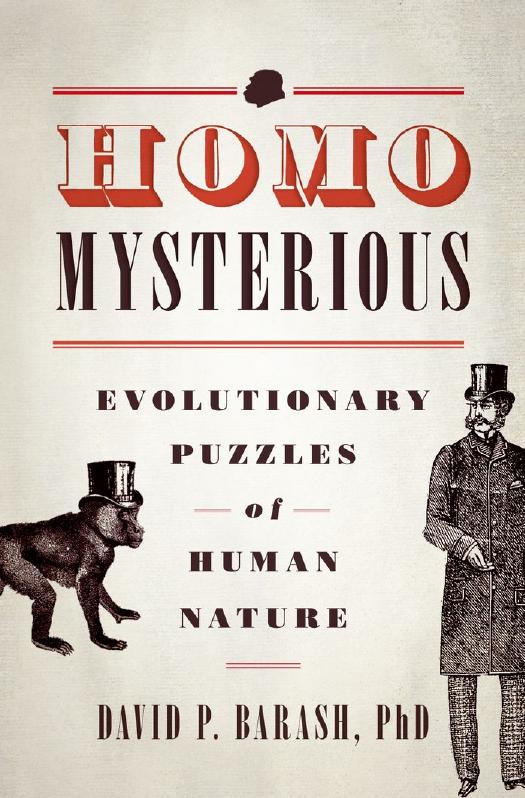Homo Mysterious: Evolutionary Puzzles of Human Nature by David P. Barash

Author:David P. Barash
Language: eng
Format: mobi, epub, pdf
Tags: Non-Fiction, Biology, Sociology, Social Science, Science, Cultural Anthropology, v.5, 21st Century, General, Anthropology, Life Sciences, Cultural, Evolution, Amazon.com, Social Psychology, Retail, Cultural History, Psychology
ISBN: 9780199751945
Publisher: Oxford University Press
Published: 2012-06-29T00:00:00+00:00
But positing an “instinct” for mimesis no more explains its existence than does the claim that people engage in art simply because they have an art instinct.i In his book Creative Evolution, French philosopher Henri Bergson argued that the key to evolution—and to consciousness—was possession of an élan vital, to which biologist Julian Huxley responded that this helped explain the nature of life about as much as we illuminate the nature of a railway engine by pointing to its “élan locomotif.” (A few centuries earlier, in Molière’s The Imaginary Invalid, we learned similarly, from a quack doctor, that opium causes sleep by virtue of its “soporific power.”) The biologically relevant question is, “Why are people moved to imitate aspects of the real world?” Such imitation, even when undertaken seriously, has an unmistakably playful component.
Human beings are the most playful of animals, and in his book On the Origin of Stories, Brian Boyd argues for play as the keystone adaptive payoff of the arts. Art, he points out, inspires cognitive processing of complex information patterns and is therefore good for us; moreover, it does so in a context that—for all its seriousness—is nonetheless one step removed from the real world, thereby allowing a greater margin for error while giving free rein to imagination and experimentation.
Dogs use their characteristic “play-bow” (head, shoulders, and front legs down, rear legs and back elevated) to indicate that what is to follow is “cognitively decoupled” from other, more serious acts. People use “once upon a time.” Boyd points out that “in play we act as if within quotation marks,” and that
we can define art as cognitive play with pattern. Just as play refines behavioral options over time by being self-rewarding, so art increases cognitive skills, repertoires, and sensitivities. A work of art acts like a playground for the mind, a swing or a slide or a merry-go-round of visual or aural or social pattern. The more often and the more exuberantly animals play, the more they hone skills, widen repertoires, and sharpen sensitivities. Play therefore has evolved to be highly self-rewarding. Through the compulsiveness of play, animals incrementally alter muscle tone and neural wiring, strengthen and increase the processing speed of synaptic pathways, and improve their capacity and potential for performance in later, less forgiving circumstances.
Download
Homo Mysterious: Evolutionary Puzzles of Human Nature by David P. Barash.epub
Homo Mysterious: Evolutionary Puzzles of Human Nature by David P. Barash.pdf
This site does not store any files on its server. We only index and link to content provided by other sites. Please contact the content providers to delete copyright contents if any and email us, we'll remove relevant links or contents immediately.
| Anthropology | Archaeology |
| Philosophy | Politics & Government |
| Social Sciences | Sociology |
| Women's Studies |
Born to Run: by Christopher McDougall(7028)
The Leavers by Lisa Ko(6876)
iGen by Jean M. Twenge(5326)
Sapiens by Yuval Noah Harari(5264)
The Kite Runner by Khaled Hosseini(5038)
Spare by Prince Harry The Duke of Sussex(4996)
Bullshit Jobs by David Graeber(3994)
Machine Learning at Scale with H2O by Gregory Keys | David Whiting(3970)
Never by Ken Follett(3703)
Goodbye Paradise(3666)
Livewired by David Eagleman(3623)
Fairy Tale by Stephen King(3156)
Harry Potter 4 - Harry Potter and The Goblet of Fire by J.K.Rowling(2942)
A Dictionary of Sociology by Unknown(2924)
The Social Psychology of Inequality by Unknown(2900)
The Club by A.L. Brooks(2812)
Will by Will Smith(2735)
0041152001443424520 .pdf by Unknown(2727)
People of the Earth: An Introduction to World Prehistory by Dr. Brian Fagan & Nadia Durrani(2673)
